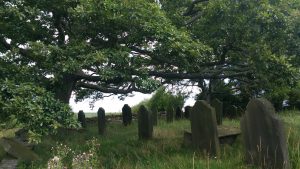 This would be a fine place to spend eternity.
This would be a fine place to spend eternity.
From the lichened drystone wall where I sat the land rolled away to the horizon, a series of gradual grassy undulations punctuated with clumps of shrubs and trees. In the distance the peat browns and heather purples of the moor spread their muted patchwork; within the tiny churchyard itself, oaks, ashes and other trees were stretching their limbs over weathered gravestones which tilted at gentle angles in the long, wildflower-scattered grass. 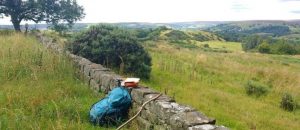 The road’s roar here was no more than a soft background wash of noise; the breeze stirred a gentle music from the leaves overhead; and amongst the grasses the crickets were chirping, their busy song oddly resembling the gentle ticking of bicycle spokes. A lush weeping beech stood sentinel at the gate, and the brown stone of the small chapel seemed a sort of organic outcropping, fitting perfectly in this peaceful and lovely space. It felt like a privilege to be there: a time-out from time: truly, a place of rest.
The road’s roar here was no more than a soft background wash of noise; the breeze stirred a gentle music from the leaves overhead; and amongst the grasses the crickets were chirping, their busy song oddly resembling the gentle ticking of bicycle spokes. A lush weeping beech stood sentinel at the gate, and the brown stone of the small chapel seemed a sort of organic outcropping, fitting perfectly in this peaceful and lovely space. It felt like a privilege to be there: a time-out from time: truly, a place of rest.
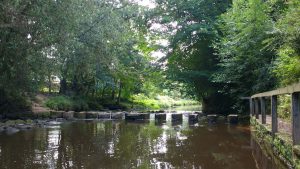 In a more than usually literal way we’d shaken the Arncliffe Arms’ dust from our feet quite early this morning, after a polite but frank exchange with the owner who, after some brief blustering, had issued a substantial refund and (I feel bound to note) cooked us a pretty good breakfast. Our route to the Egton Mortuary Chapel and Churchyard took us past the Beggar’s Bridge and through some beautiful dappled broadleaf woods, where the path of worn trods was slippery with damp. We were led over stepping stones cunningly tapered at the upstream edge to allow the water to pass more easily, and past a bench with a plaque to John and Jinny Cammack, who were remembered with the beautiful words which head this post.*
In a more than usually literal way we’d shaken the Arncliffe Arms’ dust from our feet quite early this morning, after a polite but frank exchange with the owner who, after some brief blustering, had issued a substantial refund and (I feel bound to note) cooked us a pretty good breakfast. Our route to the Egton Mortuary Chapel and Churchyard took us past the Beggar’s Bridge and through some beautiful dappled broadleaf woods, where the path of worn trods was slippery with damp. We were led over stepping stones cunningly tapered at the upstream edge to allow the water to pass more easily, and past a bench with a plaque to John and Jinny Cammack, who were remembered with the beautiful words which head this post.* 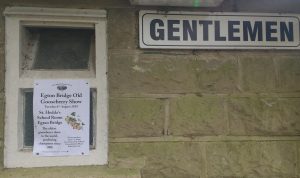 While Jenny nipped into the public loos—first rule of walking: never miss the chance to pee in (relative) comfort—I enjoyed the poster on its wall outside; then we visited St Hilda’s Roman Catholic Church where I wanted to see the gorgeous window commemorating Nicholas Postgate, martyred at Tyburn in 1679.
While Jenny nipped into the public loos—first rule of walking: never miss the chance to pee in (relative) comfort—I enjoyed the poster on its wall outside; then we visited St Hilda’s Roman Catholic Church where I wanted to see the gorgeous window commemorating Nicholas Postgate, martyred at Tyburn in 1679.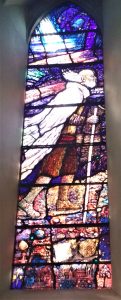 I marvelled inwardly at the relics preserved in a case (they included a faded brown splodge of blood on a piece of paper; I mean, what??) and was just about ready to leave when the priest appeared from vestry. We approached to shake hands and say hello. He seemed big-eyed and ill at ease: so different from the warm, relaxed friendliness of Ian in Hinderwell. This may have had something to do with the fact that he was expecting a couple seeking marriage preparation; certainly when he spotted a man and woman at the back of the church he moved off with alacrity and an air of relief. Quietly we saw ourselves out and headed uphill, making for the Mortuary Chapel and churchyard just outside Egdon, where the original St Hilda’s church had stood for some six hundred odd years till it was demolished in 1875.
I marvelled inwardly at the relics preserved in a case (they included a faded brown splodge of blood on a piece of paper; I mean, what??) and was just about ready to leave when the priest appeared from vestry. We approached to shake hands and say hello. He seemed big-eyed and ill at ease: so different from the warm, relaxed friendliness of Ian in Hinderwell. This may have had something to do with the fact that he was expecting a couple seeking marriage preparation; certainly when he spotted a man and woman at the back of the church he moved off with alacrity and an air of relief. Quietly we saw ourselves out and headed uphill, making for the Mortuary Chapel and churchyard just outside Egdon, where the original St Hilda’s church had stood for some six hundred odd years till it was demolished in 1875.
Knowing I needed some time alone with my griefs, Jenny left me to it. I sat in silence, doing the work I needed to do. Letting go is so hard and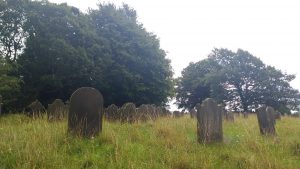 , like dusting, it doesn’t seem to stay done; it’s an iterative process. However, after three quarters of an hour or so I felt refreshed and calmed, ready to move on. We walked back to Egdon and down through the village of honey-coloured houses to the new St Hilda’s church. It’s hard to be fair about it, given that I was experiencing it after such a cathartic and beautiful experience at the old churchyard; but I didn’t find it a live or moving place, trim and well-tended though it was.
, like dusting, it doesn’t seem to stay done; it’s an iterative process. However, after three quarters of an hour or so I felt refreshed and calmed, ready to move on. We walked back to Egdon and down through the village of honey-coloured houses to the new St Hilda’s church. It’s hard to be fair about it, given that I was experiencing it after such a cathartic and beautiful experience at the old churchyard; but I didn’t find it a live or moving place, trim and well-tended though it was. 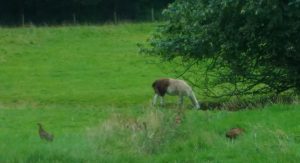 We walked back down to the beginning of this ‘Egdon loop’ and turned left onto a lane though somebody-or-other’s estate. His lordship was rich in llama and pheasant; a sign on an old toll house was a reminder of just how it is that the rich get richer. You have to pay, even when you’re dead…
We walked back down to the beginning of this ‘Egdon loop’ and turned left onto a lane though somebody-or-other’s estate. His lordship was rich in llama and pheasant; a sign on an old toll house was a reminder of just how it is that the rich get richer. You have to pay, even when you’re dead…
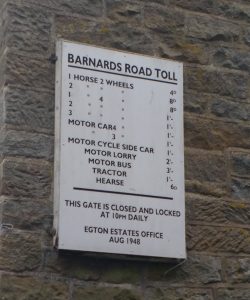 Along this section, which took us beside a river, then away from it, then back again,we stopped to examine the map, looking for a likely spot for lunch. And lo! You guessed it. A middle-aged couple approached. “Are we lost?” said the man, his use of the plural pronoun just so exquisitely patronising. “We’re not; are you?” I replied crisply. They walked off.
Along this section, which took us beside a river, then away from it, then back again,we stopped to examine the map, looking for a likely spot for lunch. And lo! You guessed it. A middle-aged couple approached. “Are we lost?” said the man, his use of the plural pronoun just so exquisitely patronising. “We’re not; are you?” I replied crisply. They walked off.
A wasp-y lunch was followed by a wasp-y scone, jam and cream in nearby Grosmont where we could hear, from our table in the garden of the Hazelwood tearooms, the occasional hisses and whoomphs of a steam train in the adjacent station; it was like having afternoon tea with Ivor the Engine. We struggled a bit getting our belts done up over the quantity of food we’d taken on. 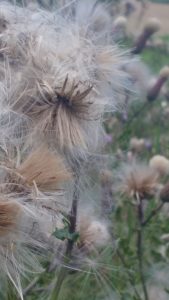 More fields; past the very desirable Newbiggin farm where a silent toddler stood astride her little bike, watching us with large, dark eyes as we drew near. A sign warned us that we were in a ‘Horse Watch Neighbourhood’ (my, this was a different country!). Elegant horses grazing in deep green fields; banks of downy thistles; a brief bit of uphill through more sun-dappled woods, where hazel cobs were strewn everywhere on the muddy ground. Two men came up behind us. “Is this the way to Whitby?” the elder one asked (thus leaving me with “Amarillo” going round my head for the rest of the afternoon: thanks, friend!). We confirmed that it was, struck by their willingness to ask for help and their—shall we say?—boldness in setting out on a long walk with only the Leaping Salmon to follow. They soon disappeared in the distance, and we ambled on.
More fields; past the very desirable Newbiggin farm where a silent toddler stood astride her little bike, watching us with large, dark eyes as we drew near. A sign warned us that we were in a ‘Horse Watch Neighbourhood’ (my, this was a different country!). Elegant horses grazing in deep green fields; banks of downy thistles; a brief bit of uphill through more sun-dappled woods, where hazel cobs were strewn everywhere on the muddy ground. Two men came up behind us. “Is this the way to Whitby?” the elder one asked (thus leaving me with “Amarillo” going round my head for the rest of the afternoon: thanks, friend!). We confirmed that it was, struck by their willingness to ask for help and their—shall we say?—boldness in setting out on a long walk with only the Leaping Salmon to follow. They soon disappeared in the distance, and we ambled on.
Approaching Sleights we faced the visual and auditory assault that was the A169: our boarding house lay on the other side, quite a long way up, and the footbridge which would have taken us away from the main road was closed. We toiled uphill in the sun and the noise and were glad to get to the Rowantree. The kind but quite unrelaxed-seeming landlady welcomed us, and after some washing, popping of blisters and faffing with packs we went up the road to the Plough where a table had been booked for our supper.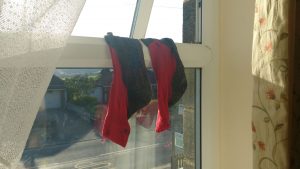 I sighed at the menu—vegetarianism really hasn’t made significant inroads into this pocket of Yorkshire—and ended up with onion rings, double side of veg, and chips. A large Pinot G helped. I wrote my notes and Jenny looked at tomorrow’s map. I felt so glad of the relaxed, companionable silence and routine that had grown between us. A gift from St Hilda.
I sighed at the menu—vegetarianism really hasn’t made significant inroads into this pocket of Yorkshire—and ended up with onion rings, double side of veg, and chips. A large Pinot G helped. I wrote my notes and Jenny looked at tomorrow’s map. I felt so glad of the relaxed, companionable silence and routine that had grown between us. A gift from St Hilda.
Back at the B and B we had to choose from yet another breakfast menu: absolutely inoffensive in itself, but the surfeit of fried goods was getting really wearisome. I was reminded of when Lem and I took our road trip round Ontario a few years ago. I’d been so excited at the prospect of eating at a diner—it seemed so other, so glamorous, so Hopper—but after a few days I’d become sick of eggs, potatoes and grease in all their many guises. The following morning’s iteration turned out to include those very uptight-looking poached eggs done in plastic pods. While it was all unexceptionable here—Dee the landlady was helpfulness itself—I didn’t feel at ease, somehow. Still, we lingered over breakfast as long as we could: there was Jenny’s lovely hand-made pop-up birthday card to enjoy, and besides, the likelihood of rain was ≥ 95% (!). Which is to say: it was tipping it down.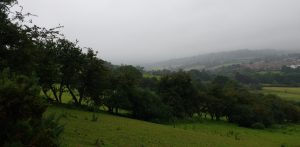 We had recourse to Jenny’s cheer-you-up standby (looking at pictures of black-nose sheep on the internet)** but eventually got into our rustliest, most waterproof kit (or in my case, cag and shorts) and set out into the gloom. I was sad at the thought that it was our final day’s walking but, once we got on the road, found I shook the mood off—got absorbed in that steady, wonderful rhythm of one foot in front of the other.
We had recourse to Jenny’s cheer-you-up standby (looking at pictures of black-nose sheep on the internet)** but eventually got into our rustliest, most waterproof kit (or in my case, cag and shorts) and set out into the gloom. I was sad at the thought that it was our final day’s walking but, once we got on the road, found I shook the mood off—got absorbed in that steady, wonderful rhythm of one foot in front of the other.
Too absorbed, perhaps. Over the soggy, thistly fields we missed a couple of Salmon and ended up doing a fair amount of slithering and backtracking, grateful once again for the magic arrow on the OS app. Things got particularly confusing around Buskey House farm: the SHW guidebook claimed there were waymarkers a-plenty, but we couldn’t find them, and did a lot of thrashing and blundering through thistles and around piles of that distinctive farm debris of discarded machinery, bale wrappers, twine and—well, shit. My legs were weary and I struggled to lift them over one particularly high stile between dense and thorny hedges. It was slippery and I couldn’t work out where to put my feet. Waaa.
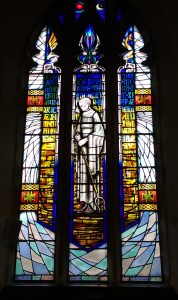 We consoled ourselves with thoughts of a cappuccino in Sneaton, where we were heading to look at yet another Hilda church. This one was full of light; had a sense of life and a great acoustic; and there was for sale at the back all sorts of jams and chutneys and knitted goods mysterious in purpose but high in quality and heartwarming in their earnest, multicoloured, woolly glory. There was a window to St Caedmon who apparently learned to compose in a dream one night (so that’s how it’s done) and who was encouraged to write by Hilda. The guidebook described him as “the earliest English poet whose name is known”. I saluted him: Brother Caedmon.
We consoled ourselves with thoughts of a cappuccino in Sneaton, where we were heading to look at yet another Hilda church. This one was full of light; had a sense of life and a great acoustic; and there was for sale at the back all sorts of jams and chutneys and knitted goods mysterious in purpose but high in quality and heartwarming in their earnest, multicoloured, woolly glory. There was a window to St Caedmon who apparently learned to compose in a dream one night (so that’s how it’s done) and who was encouraged to write by Hilda. The guidebook described him as “the earliest English poet whose name is known”. I saluted him: Brother Caedmon.
Poet, not barista, though. Coffee would have to wait. We left the church and turned left to pick up the Monk’s Walk which would take us the rest of the way to Whitby. 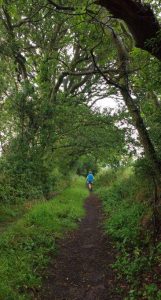 The Walk’s worn, slippery trods led us between drippy hedges, under overarching trees, and, initially, alongside a large camp site. Eventually, however, we left behind the smell of fuel and the sound of generators and were able to feel the atmosphere of this centuries’ old path. Steeply down through woods we went; climbed a bit; came out between fields where the sky was beginning to clear and we dared to de-cag. At a “confluence of footbridges” we turned left and went steeply uphill again towards the ‘main’ road. This gloriously dripping wood, pierced here and there with freshly-rinsed shafts of sunlight, would be our last bit of green. We were nearly there.
The Walk’s worn, slippery trods led us between drippy hedges, under overarching trees, and, initially, alongside a large camp site. Eventually, however, we left behind the smell of fuel and the sound of generators and were able to feel the atmosphere of this centuries’ old path. Steeply down through woods we went; climbed a bit; came out between fields where the sky was beginning to clear and we dared to de-cag. At a “confluence of footbridges” we turned left and went steeply uphill again towards the ‘main’ road. This gloriously dripping wood, pierced here and there with freshly-rinsed shafts of sunlight, would be our last bit of green. We were nearly there.
When we emerged onto the cinder track which took us over the railway we had our first sight of the Abbey. We rounded St Caedmon’s College sports field and then faced the prospect of crossing the A171. It seemed so violent; the crossing so impossible. Four days in the country and we had turned into turnip heads. We did manage to scuttle across, but the experience left me reflecting on quite how much energy we must unconsciously use tuning out the telegrams, anger and noise of everyday life. This seemed a sad thought. I’d like to live in a way which means less of my energy goes on not noticing, so that even more is available for registering the lovely stuff.
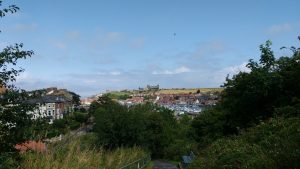 When we stopped to admire the abbey there on the clifftop, brown against a miraculously blue sky, I could feel my throat swell, my eyes fill, with pride, joy, sorrow, relief. Journey’s end in sight. The path took us back into ‘civilisation’: through residential streets, along the river’s edge, and at last back to the car park where PK was waiting for us—significantly more covered in birdshit than he had been but safe and sound and ready to swallow our packs so we could make the final ascent to the Abbey unencumbered. The glory of taking the boots off wasn’t so great as it had been last year on the SBW, because my feet weren’t in nearly such a bad state; but still, it was lovely to have my toes out in the sunny air and only a few things to carry, in my drybag, as we walked off past the Endeavour and towards Caedmon’s Trod, the 199 steps which lead up to the Abbey. A magnificent but very pissed-off looking Bengal cat on a lead (his name was Dave, apparently) was coming down the slope next to the steps; perhaps he too found the bustle of people on the steps and narrow cobbled streets almost unbearable.
When we stopped to admire the abbey there on the clifftop, brown against a miraculously blue sky, I could feel my throat swell, my eyes fill, with pride, joy, sorrow, relief. Journey’s end in sight. The path took us back into ‘civilisation’: through residential streets, along the river’s edge, and at last back to the car park where PK was waiting for us—significantly more covered in birdshit than he had been but safe and sound and ready to swallow our packs so we could make the final ascent to the Abbey unencumbered. The glory of taking the boots off wasn’t so great as it had been last year on the SBW, because my feet weren’t in nearly such a bad state; but still, it was lovely to have my toes out in the sunny air and only a few things to carry, in my drybag, as we walked off past the Endeavour and towards Caedmon’s Trod, the 199 steps which lead up to the Abbey. A magnificent but very pissed-off looking Bengal cat on a lead (his name was Dave, apparently) was coming down the slope next to the steps; perhaps he too found the bustle of people on the steps and narrow cobbled streets almost unbearable. 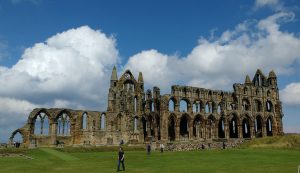 And then we couldn’t get to the ruins themselves without going through The Abbey Experience (or was it The Dracula Experience?); I really wasn’t in the mood and zoomed through the museum. At the exit, a smiling young woman invited us to evaluate our Experience. I told her it was my birthday and that my present to myself was not having to evaluate any experiences. She laughed. I think she understood. She was doing an unpleasant job with great cheerfulness and grace.
And then we couldn’t get to the ruins themselves without going through The Abbey Experience (or was it The Dracula Experience?); I really wasn’t in the mood and zoomed through the museum. At the exit, a smiling young woman invited us to evaluate our Experience. I told her it was my birthday and that my present to myself was not having to evaluate any experiences. She laughed. I think she understood. She was doing an unpleasant job with great cheerfulness and grace.
Grace, too, was what I had a sense of as I sat for a silent half hour or so, there on the clifftop in the shelter of the splendid Abbey ruins. That so many seats of worship should be sited by the sea made sense to me suddenly. To look out on the apparently-infinite space—on eternity—has something to teach you about your own smallness and finiteness: how (in the end) you have to let go of all of it, of every single thing that is in your life, that is you; but that when you have done so, all that remains is the present, your awareness of it, your aliveness, what you treasure: Love. I sat there overflowing with gratitude for everything: the loves, people and dreams I’m relinquishing and those I rejoice to “possess”; the feel of the warm sun drying the tears on my face, the breeze whipping my hair, the tautness in my nettle-stung legs, the happiness of my toes, the squeals of wind-giddy toddlers playing nearby; the prospect of a birthday lunch featuring actual vegetables and pulses… I reckoned Larkin had it right after all, whatever his own doubts. What is the light at the heart of our experiencing? What else is there? What will survive of us is love.
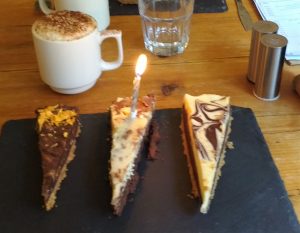
*You can read the poem from which this line comes here.
**Have a look: I defy you not to crack a smile!
What a beautiful experience; I am enjoying your pilgrimages. The horse sign struck a chord; nearby we have a sign ‘Think horse’ just ahead of a steep rise – every time I cycle up it, I repeat the mantra in my head ‘horse, horse, horse’ – small things and all that!
So glad you’re enjoying coming with me! Thank you for letting me know. I laughed to think of you mentally chanting as you toil up the hill. As you say, small things! x